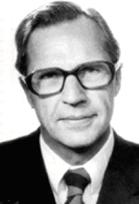ALERT!
This site is not optimized for Internet Explorer 8 (or older).
Please upgrade to a newer version of Internet Explorer or use an alternate browser such as Chrome or Firefox.
Viking Olov Björk – 1918 - 2009
 Professor emeritus Viking Olov Björk, the first editor of the Scandinavian Journal of Thoracic and Cardiovascular Surgery died on February 18, 2009 in Stockholm at the age of 90 years. He was born on December 3, 1918 in Sunnansjö, Dalecarlia, Sweden.
Professor emeritus Viking Olov Björk, the first editor of the Scandinavian Journal of Thoracic and Cardiovascular Surgery died on February 18, 2009 in Stockholm at the age of 90 years. He was born on December 3, 1918 in Sunnansjö, Dalecarlia, Sweden.
Viking Björk was active as a cardiothoracic surgeon during the era of rapid development in modern techniques and management of lung and open heart surgery. He was the head of cardiothoracic surgery in Uppsala 1958-1966 and received a professorship in 1962. In 1966 he was called to the chair of thoracic and cardiovascular surgery at Karolinska Institute in Stockholm and was appointed head of the Thoracic Surgical Clinic at the Karolinska Hospital. He remained the leader of this clinic for 27 years and retired in 1983.
During the Second World War, Viking Björk received scholarships to study lung tuberculosis with Monaldi at the Carlo Forlanini Institute in Rome and travelled to Brompton Hospital in London where he worked with Russell Brock. He learned the principles of pulmonary surgery from Tudor Edwards and Clement Price Thomas and wrote the monograph Bronchogenic Carcinoma based on 348 treated patients. After returning from London he was invited to work with Clarence Crafoord at the Sabbatsberg Hospital in Stockholm. After two years of hard developmental work he successfully performed extracorporeal brain perfusion in a 27 kg dog for 33 minutes with the aid of a disc oxygenator. The blood in the apparatus was oxygenated using rotating discs of stainless steel covered with silicone to assure blood compatibility. His doctoral thesis presented in 1948, “Brain perfusions in dogs with artificially oxygenated blood”, laid the foundation for early development of open cardiac surgery in Sweden.
At Sabbatsberg Hospital pioneer work was performed such as the world’s first aortic coarctation resection on October 19, 1944 and the second successful operation in the world using a heart-lung machine on July 16, 1954. Viking Björk was in charge of pulmonary surgery and performed more than 1500 lung operations. He introduced postoperative respirator treatment as a part of lung resection procedures in patients with reduced lung function and devised osteoplastic roof thoracoplasty after lung resection in patients with tuberculosis during the 1950’s. He introduced left heart catheterization by direct needle puncture from the back to the right of the spine. The patient was given a sip of alcohol (a “snaps”) prior to the examination in case the needle penetrated the oesophagus. A catheter could be passed through the needle and via the left atrium into the left ventricle and aorta.
Viking Björk’s impressive scientific contributions included 438 published papers on topics including myocardial protection, obstructive cardiomyopathy, transatrial approach and detachment of the septal tricuspid leaflet for repair of ventricular septal defects, techniques to repair atrio-ventricular septal defect, modification of the Fontan procedure and many other papers on surgical correction for congenital heart defects. Viking Björk never hesitated to report complications such as the dangers associated with deep hypothermia, the risk of suturing the circumflex coronary artery during mitral valve surgery and the risk of left ventricular rupture after mitral valve replacement. He performed the first coronary artery bypass operation in Sweden in June 1970 and introduced the use of the internal mammary artery graft in 1972.
Viking Björk was dissatisfied with the prosthetic heart valves available at that time. His name is associated with the Björk-Shiley mechanical tilting disc valve which was introduced clinically at the Karolinska Hospital in January 1969. A large number of papers and five dissertations were based on careful haemodynamic evaluations and follow-up of patients who received the Björk-Shiley valve. The valve was refined several times regarding material and opening angle. For a while it was the most widely used mechanical prosthesis world-wide. The Björk-Shiley valve suffered the disaster of outlet strut fracture during the early 1980’s, a problem which terminated the use of this prosthesis.
Viking Björk was a hard-working, dominating, energetic and enthusiastic surgeon with a world-wide contact network. Love for his home county and his family permeated throughout life. He enjoyed sailing in a fresh breeze and to watch the timber on his forest lands grow. During his long career he travelled to medical centres and meetings all over the world to lecture and learn about cardiothoracic surgery. He was appointed Honorary Member of the American Association of Thoracic Surgery and the American College of Cardiology. The Thoracic Clinic at the Karolinska Hospital was highly regarded and surgeons from countries including Poland, Italy, Finland, Ecuador and Brazil came to visit, and some of them stayed for many years to learn cardiac surgery. His clinic was an academic educational institution and apprenticeship school. Members of his team became leading surgeons and heads of departments in Uppsala, Örebro, Gothenburg, Linköping, Lund, Karlskrona and Huddinge in Sweden, in Kuopio in Finland, Quito in Equador and Debrecen in Hungary.
Torbjörn Ivert, MD
Department of Thoracic Surgery
Karolinska University Hospital
Stockholm, Sweden
Dan Lindblom, MD, PhD
Department of Cardiothoracic Surgery and Anesthesiology
Karolinska University Hospital
Stockholm, Sweden
Christian Olin, MD
Department of Cardiothoracic Surgery
University Hospital
Linkoeping, Sweden
Stockholm, March 2009
This obituary will also be published in The Scandinavian Cardiovascular Journal




